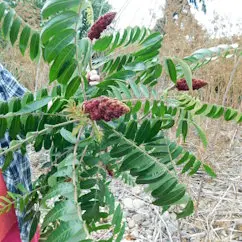We Don’t Lack for Sumac
by Marcia Wilson

Environmental Science students combine forces at least once a month to remove invasive species of plants from the CPTC property. Sometimes, a plant is merely watched. It isn’t enough of a problem to remove it; it may even help the wildlife.
This is Rhus typhina, better known as Staghorn Sumac. For a brief and glorious moment, it looked like the school had its native relative, Smooth Sumac on the marsh property. Close inspection sadly ruled it out. The “staghorn” comes from the upright thick clumps of drupes which bear some resemblance to a “buck in velvet”.

For the foodies it was still a good discovery, and for the marsh birds it was a more nutritious alternative to the Himalaya blackberries while providing a much-needed shelter from predators.
Humans are attached to their food sources even if they aren’t attached to plants in general. Staghorn Sumac followed nostalgic or homesick newcomers to the area from its native range on the Eastern Seaboard. Similarly, the Smooth Sumacs were brought over the mountains from the Eastern Side of Washington State.
For the Birds and the Bird-Lovers
This sumac stand grows small and thick like a deeply shaded umbrella where the college populations of hawks, falcons, and kestrels are watching for a meal. Many people have an affinity for birds and sumac feeds many of these feathered friends, including the Western Bluebird. The berries lose their flavor after a rain, but the fuzz collects raindrops, providing a welcome drink for birds that are vulnerable to predators by drinking on the ground.

Sumacs belong to the Anacardiaceae family. They are related to cashews, mangoes and pistachios. The rule of thumb tends to be the same throughout the world regardless of the many sumac species: If it has a red berry, it is likely edible. If it has a white berry, it is probably poisonous. That said, always verify with a trusted source whether a berry of any color can be eaten safely.
Same Family, Different Members
In Western Washington, the Staghorn and Smooth Sumacs are the most likely to be found. Both are striking with glowing red-orange autumn foliage, dark green summer leaves, and lush red fruits. They look very much alike, but the Staghorn can grow to the size of a small tree while the Smooths tend to be closer to shrub size.
Smooth Sumac has the greatest amount of folklore, culinary, and medicinal practices for Washington State. Both are appealing, and small thickets are planted for aesthetic purposes as well as to feed the birds.
Spice is Nice
Large amounts of sumac sit on the store shelves in Washington State. Most Americans have already eaten it if they have enjoyed Greek, Roman, and Middle Eastern dishes. “Sumac” recalls the older “summaq” which is the Syrian for “red”. This is an important ingredient for the wonderful za’atar seasoning, an important element in global cooking. Red Za’atar is the form that uses red sumac. That may seem obvious, but “smooth sumac” isn’t exactly smooth; many descriptive terms in the world are not precise.
By itself, the berries were once called “poor man’s salt” in Appalachia and considered a famine food. It was rarely served to outsiders. The berries have a tart, lemony flavor on the tongue if the flavorful acids in the fuzz are not rinsed out by rain. Sumac is rich in Vitamin C and often replaces lemon in dishes where lemon is not available: Sumac can grow in the meanest, leanest of earths like wastelands, abandoned lots, and railroad tracks.
Home Cooking

Sumac Za’atar has many forms and flavor variations. To generically call all the za’atar the same is no different than saying there is only one brand of barbecue sauce for the North American continent. Thousands of variations of za’atar exist and the recipes can be secretive, jealously handed down in the families. It is possible for a Puget Sound Shopper to go to five different stores and walk out with five different brands of seasonings, salts, and flavors with sumac. One creative Tacoman, owner of ALL THINGS RICH, has a good sampling of what one person can provide with some initiative and a good supply of sumac.
Dye, Invasives, Dye
Like many species that are not native to an area, sumacs can be invasive. When simple eradication is impossible, the next best thing to do to an invasive species is to make use of it. Municipalities around the world have had to employ creativity to enlist the public to assist with the process. One solution for dealing with invasive lionfish in the Caribbean and off the coasts of Florida is to eat them, a tactic that works for reducing the ranks of some, though not all, invaders.
In the case of wild sumac overtaking a region in Slovenia, the city of Ljubljana in Slovenia chose to exploit their non-native sumac problem by offering a tutorial on turning the berries into dye. Their approach is – pardon the pun – to dye for!